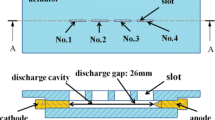Abstract
The flow induced by plasma synthetic jet actuator was simulated through solving the Reynolds-averaged Navier-Stokes equations augmented by body force phenomenological plasma model. The effect of actuation frequency on the plasma synthetic jet was examined by case study. The numerical results present that with the actuation frequency increasing, the stream-wise distance of the adjacent vortex pairs induced by the actuator decreases monotonically, which is the same as the situation of the velocity fluctuations field caused by the vortex pairs. When the actuation frequency is 60 Hz, the vortex pairs formed during the adjacent actuation periods merge together quickly, and the flow structure in the downstream region is more close to that of the steady case. The actuation frequency has no visible influence on the time-averaged flow field of plasma synthetic jet. However, when the actuation frequency is relatively low (f<40 Hz), the momentum flux close to the actuator increases with the actuation frequency increasing, which is contrary to the situation in the far field from the wall.
Similar content being viewed by others
References
Glezer A, Amitay M. Synthetic jets. Annu Rev Fluid Mech, 2002, 34: 503–529
Zhang P F, Wang J J, Feng L H. Review of zero-net-mass-flux jet and its application in separation flow control. Sci China Ser E-Tech Sci, 2008, 51(9): 1315–1344
Jacob J D, Ramakumar K, Anthony R, et al. Control of laminar and turbulent shear flows using plasma actuators. Fourth Int. Symp. on Turbulence and Shear Flow Phenomena (TSFP4-225), Williamsburg, VA June 27–29, 2005
Roth J R, Sherman D M, Wilkinson S P. Boundary layer flow control with one atmosphere uniform glow discharge surface plasma. AIAA Paper 98-0328, 1998
Jukes T N, Choi K S, Johnson G A, et al. Turbulent boundary-layer control for drag reduction using surface plasma. AIAA Paper 2004-2216, 2004
Zhang P F, Liu A B, Wang J J. Flow structures in flat plate boundary layer induced by pulse plasma actuator, Sci China Tech Sci, 2010, 53(10): 2772–2782
Zhang P F, Liu A B, Wang J J. Aerodynamic modification of a NACA 0012 airfoil by trailing-edge plasma gurney flap. AIAA J, 2009, 47(10): 2467–2474
Zhang P F, Yan B, Liu A B, et al. Numerical simulation on plasma circulation control airfoil. AIAA J, 2010, 48(10): 2213–2226
Zhang P F, Wang J J, Feng L H, et al. Experimental study of plasma flow control on highly swept delta wing. AIAA J, 2010, 48(1): 249–252
Wu K E, Breuer K S. Dynamics of synthetic jet actuator arrays for flow control. AIAA Paper 2003-4257, 2003
Santhanakrishnan A, Jacob J D. Flow control with plasma synthetic jet actuators. J Phys D-Appl Phys, 2007, 40: 637–651
Santhanakrishnan A, Reasor D A, LeBeau R P. Characterization of linear plasma synthetic jet actuators in an initially quiescent medium. Phys Fluids, 2009, 21(9): 043602–043602-18
Liu A B, Zhang P F, Yan B, et al. Flow characteristics of synthetic jet induced by plasma actuator. AIAA J, 2011, 49(3): 544–553
Shyy W, Jayaraman B, Anderson A. Modeling of glow discharge-induced fluid dynamics. J Appl Phys, 2002, 92(11): 6434–6443
Gaitonde D V, Visbal M R, Roy S. A coupled approach for plasma-based flow control simulations of wing sections. AIAA Paper 2006-1205, 2006
Fluent Inc. Fluent 6.3 User’s Guide, Ver. 6.3.26. Lebanon, NH, 2006
Tang H, Zhong S. Two-dimensional numerical study of circular synthetic jets in quiescent flows. Aeronaut J, 2005, 109(2): 89–97
Zhang P F, Wang J J. Novel signal wave pattern for efficient synthetic jet generation. AIAA J, 2007, 45(5): 1058–1065
Rumsey C L. Successes and challenges for flow control simulation. AIAA Paper 2008-4311, 2008
Gaitonde D V, Visbal M R, Roy S. Control of flow past a wing section with plasma-based body forces. AIAA Paper 2005-5302, 2005
Smith B L, Glezer A. The formation and evolution of synthetic jets. Phys Fluids, 1998, 10(9): 2281–2297
Author information
Authors and Affiliations
Corresponding author
Rights and permissions
About this article
Cite this article
Zhang, P., Dai, C., Liu, A. et al. The effect of actuation frequency on the plasma synthetic jet. Sci. China Technol. Sci. 54, 2945–2950 (2011). https://doi.org/10.1007/s11431-011-4546-2
Received:
Accepted:
Published:
Issue Date:
DOI: https://doi.org/10.1007/s11431-011-4546-2




